Disruptive Innovation in Apple: Strategies, Factors, and Analysis
VerifiedAdded on 2023/05/27
|11
|3164
|156
Report
AI Summary
This report delves into Apple's disruptive innovations, examining their impact on the market and the company's strategic approaches. It begins with an introduction to disruptive technology and its application to Apple's products, such as the iPod, iPhone, and iMac. The report then analyzes the level of disruption, considering affected footholds and stakeholders like customers, employees, and investors. It explores enabling factors, including social, technological, and economic aspects in countries like Singapore, and industry dynamics such as negotiating power of buyers and competitive rivalry. The report further investigates Apple's entrepreneurial ecosystem, focusing on products for prospectus, core products, and products for clients. The conclusion highlights the significance of disruptive innovation as a driving force for growth and market expansion, emphasizing the need for tailored strategic approaches. References are provided for further reading.
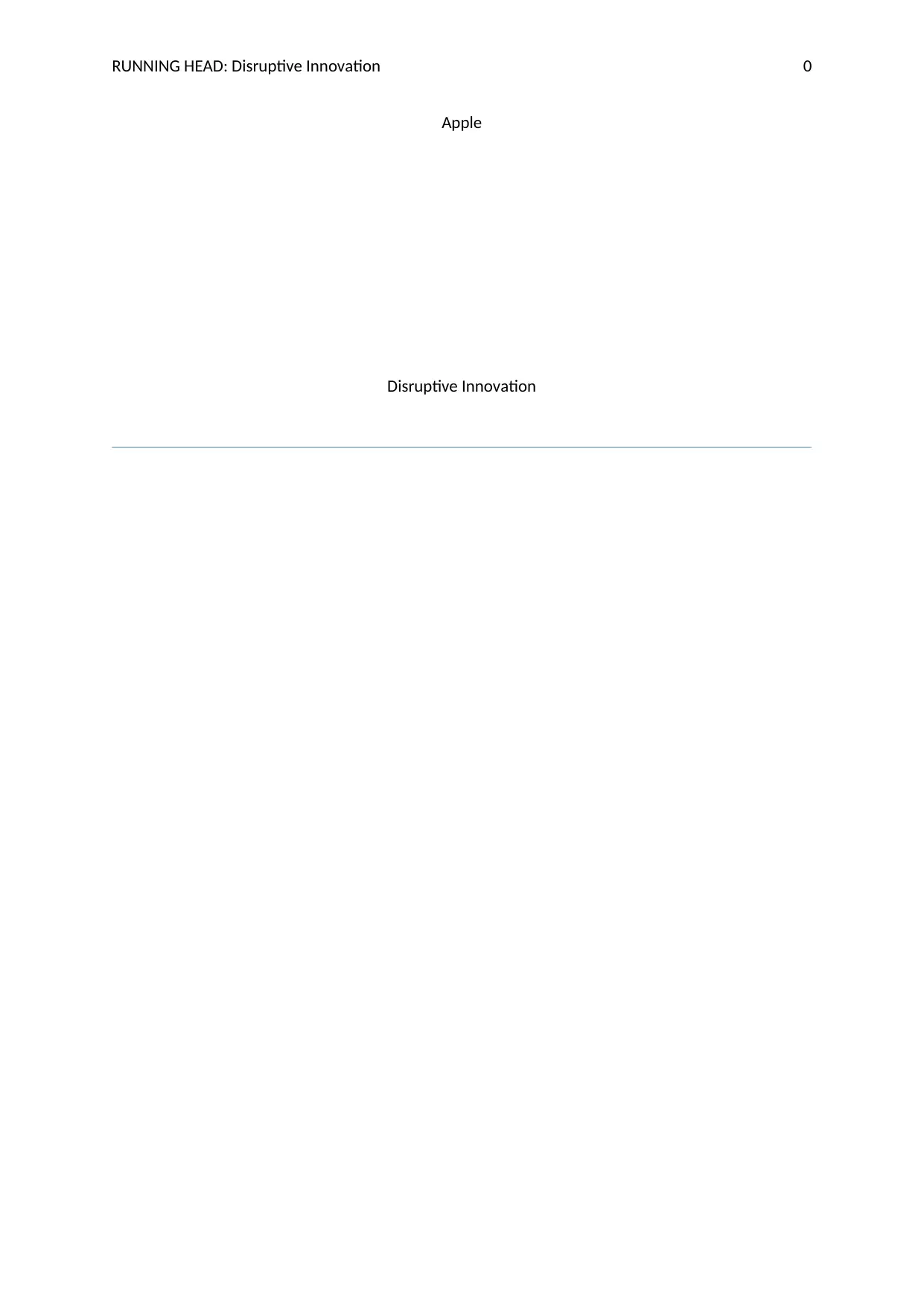
RUNNING HEAD: Disruptive Innovation 0
Apple
Disruptive Innovation
Apple
Disruptive Innovation
Paraphrase This Document
Need a fresh take? Get an instant paraphrase of this document with our AI Paraphraser

Disruptive Innovation 1
Contents
Introduction................................................................................................................................2
Level of Disruption....................................................................................................................3
Affected footholds..................................................................................................................3
Affected stakeholders.............................................................................................................3
Review of enabling factors.........................................................................................................4
Country...................................................................................................................................4
Industry...................................................................................................................................4
Entrepreneurial ecosystem......................................................................................................5
Conclusion..................................................................................................................................5
References..................................................................................................................................7
References..................................................................................................................................9
Contents
Introduction................................................................................................................................2
Level of Disruption....................................................................................................................3
Affected footholds..................................................................................................................3
Affected stakeholders.............................................................................................................3
Review of enabling factors.........................................................................................................4
Country...................................................................................................................................4
Industry...................................................................................................................................4
Entrepreneurial ecosystem......................................................................................................5
Conclusion..................................................................................................................................5
References..................................................................................................................................7
References..................................................................................................................................9

Disruptive Innovation 2
Introduction
The disruptive technology states to a technology whose application considerably affects the
way a market functions. The products of Apple have been designed to work simply and
productively. It helps employees to solve problems in creative ways (Christensen, Raynor and
McDonald, 2015). Apple is an American transnational technology company which designs,
advances and trades user electronics, computer software, and operational services. The
company was established in 1976 by Steve Jobs, Steve Wozniak, and Ronald Wayne. The
innovations of Apple are explained below:
iPod: iPod started the digital music revolution. The music player launched by the company in
2001 and it could store almost 1000 songs. The latest models added functions like photo and
video-viewing capabilities. iPad offers complete multimedia experience and allows users to
download application along with the games.
Graphic user interface: Apple produced the first commercially popular computer to use a
graphic user interface- Macintosh. It was invented in 1984 and used desktop metaphor to
monitor operators around the computer with papers signified as sheets of paper.
iMac: iMac was first invented in 1998 and marked as the major tech player. The company
ripped up the computer design rulebook and replaced with the fun and luminous machines.
iTunes: iTunes is music software of Apple to organize songs, playlists, and copy tracks. It has
frolicked a massive character in the digitization of the music industry. The invention of
iTunes has killed off the traditional album release (Nagy, Schuessler and Dubinsky, 2016).
Mac OS X: Apple’s OS X operating system was debuted in 2001. It is admired for its
classiness, ease of usage and modest edge. It comprises structures like the spotlight search
function, cover flow-style finder, video conferencing software and iChat instant messaging
has attained popularity among the users.
iPhone: It was launched in 2007 and is the greatest invention of Apple. It combined features
like internet browser, music and video player along with the capability to make and accept
calls.
Newton: Newton is a touch screen private digital assistant. Commercially it was a dank squib
and still recalled for the neat interface and handwriting recognition.
Introduction
The disruptive technology states to a technology whose application considerably affects the
way a market functions. The products of Apple have been designed to work simply and
productively. It helps employees to solve problems in creative ways (Christensen, Raynor and
McDonald, 2015). Apple is an American transnational technology company which designs,
advances and trades user electronics, computer software, and operational services. The
company was established in 1976 by Steve Jobs, Steve Wozniak, and Ronald Wayne. The
innovations of Apple are explained below:
iPod: iPod started the digital music revolution. The music player launched by the company in
2001 and it could store almost 1000 songs. The latest models added functions like photo and
video-viewing capabilities. iPad offers complete multimedia experience and allows users to
download application along with the games.
Graphic user interface: Apple produced the first commercially popular computer to use a
graphic user interface- Macintosh. It was invented in 1984 and used desktop metaphor to
monitor operators around the computer with papers signified as sheets of paper.
iMac: iMac was first invented in 1998 and marked as the major tech player. The company
ripped up the computer design rulebook and replaced with the fun and luminous machines.
iTunes: iTunes is music software of Apple to organize songs, playlists, and copy tracks. It has
frolicked a massive character in the digitization of the music industry. The invention of
iTunes has killed off the traditional album release (Nagy, Schuessler and Dubinsky, 2016).
Mac OS X: Apple’s OS X operating system was debuted in 2001. It is admired for its
classiness, ease of usage and modest edge. It comprises structures like the spotlight search
function, cover flow-style finder, video conferencing software and iChat instant messaging
has attained popularity among the users.
iPhone: It was launched in 2007 and is the greatest invention of Apple. It combined features
like internet browser, music and video player along with the capability to make and accept
calls.
Newton: Newton is a touch screen private digital assistant. Commercially it was a dank squib
and still recalled for the neat interface and handwriting recognition.
⊘ This is a preview!⊘
Do you want full access?
Subscribe today to unlock all pages.

Trusted by 1+ million students worldwide
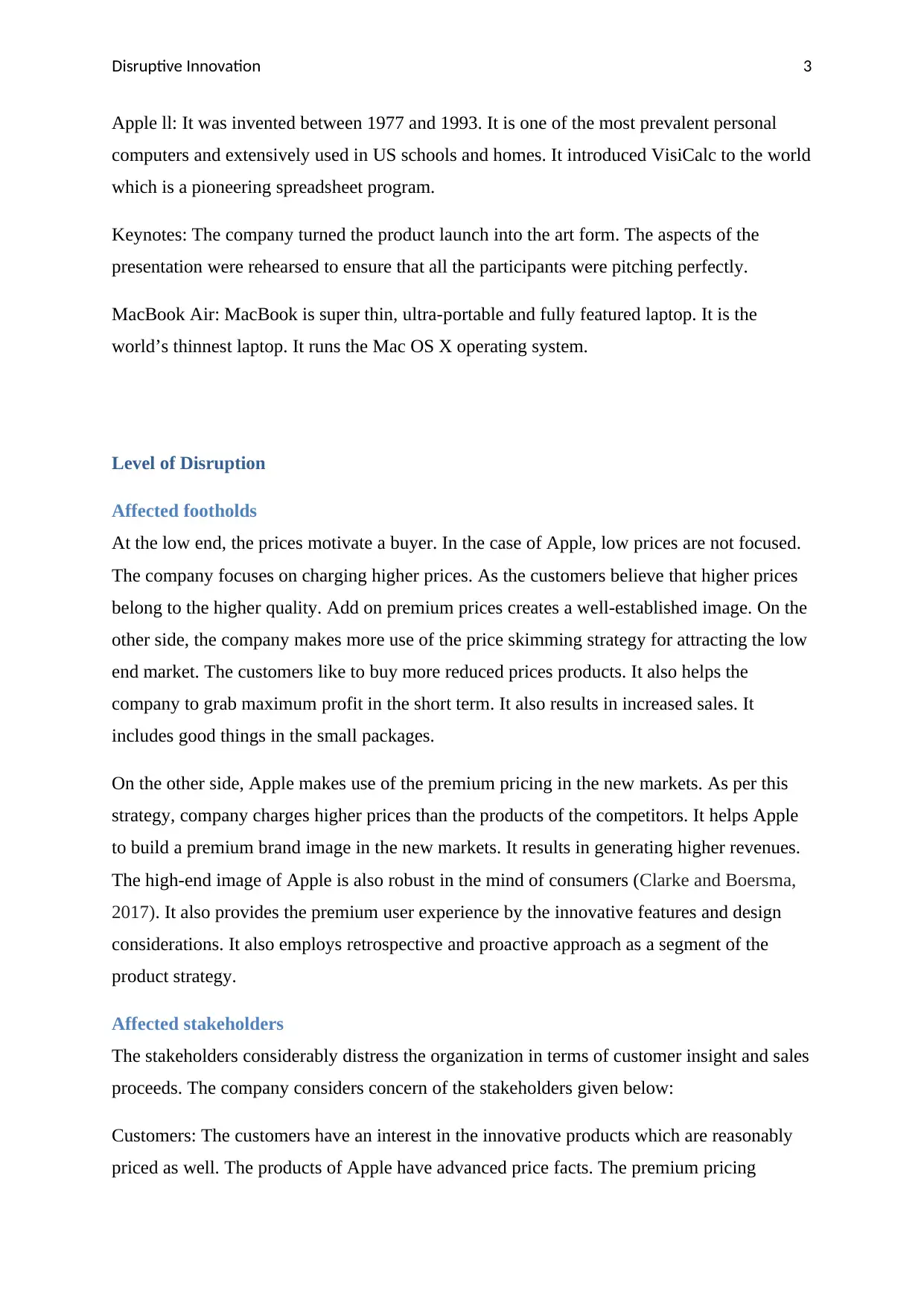
Disruptive Innovation 3
Apple ll: It was invented between 1977 and 1993. It is one of the most prevalent personal
computers and extensively used in US schools and homes. It introduced VisiCalc to the world
which is a pioneering spreadsheet program.
Keynotes: The company turned the product launch into the art form. The aspects of the
presentation were rehearsed to ensure that all the participants were pitching perfectly.
MacBook Air: MacBook is super thin, ultra-portable and fully featured laptop. It is the
world’s thinnest laptop. It runs the Mac OS X operating system.
Level of Disruption
Affected footholds
At the low end, the prices motivate a buyer. In the case of Apple, low prices are not focused.
The company focuses on charging higher prices. As the customers believe that higher prices
belong to the higher quality. Add on premium prices creates a well-established image. On the
other side, the company makes more use of the price skimming strategy for attracting the low
end market. The customers like to buy more reduced prices products. It also helps the
company to grab maximum profit in the short term. It also results in increased sales. It
includes good things in the small packages.
On the other side, Apple makes use of the premium pricing in the new markets. As per this
strategy, company charges higher prices than the products of the competitors. It helps Apple
to build a premium brand image in the new markets. It results in generating higher revenues.
The high-end image of Apple is also robust in the mind of consumers (Clarke and Boersma,
2017). It also provides the premium user experience by the innovative features and design
considerations. It also employs retrospective and proactive approach as a segment of the
product strategy.
Affected stakeholders
The stakeholders considerably distress the organization in terms of customer insight and sales
proceeds. The company considers concern of the stakeholders given below:
Customers: The customers have an interest in the innovative products which are reasonably
priced as well. The products of Apple have advanced price facts. The premium pricing
Apple ll: It was invented between 1977 and 1993. It is one of the most prevalent personal
computers and extensively used in US schools and homes. It introduced VisiCalc to the world
which is a pioneering spreadsheet program.
Keynotes: The company turned the product launch into the art form. The aspects of the
presentation were rehearsed to ensure that all the participants were pitching perfectly.
MacBook Air: MacBook is super thin, ultra-portable and fully featured laptop. It is the
world’s thinnest laptop. It runs the Mac OS X operating system.
Level of Disruption
Affected footholds
At the low end, the prices motivate a buyer. In the case of Apple, low prices are not focused.
The company focuses on charging higher prices. As the customers believe that higher prices
belong to the higher quality. Add on premium prices creates a well-established image. On the
other side, the company makes more use of the price skimming strategy for attracting the low
end market. The customers like to buy more reduced prices products. It also helps the
company to grab maximum profit in the short term. It also results in increased sales. It
includes good things in the small packages.
On the other side, Apple makes use of the premium pricing in the new markets. As per this
strategy, company charges higher prices than the products of the competitors. It helps Apple
to build a premium brand image in the new markets. It results in generating higher revenues.
The high-end image of Apple is also robust in the mind of consumers (Clarke and Boersma,
2017). It also provides the premium user experience by the innovative features and design
considerations. It also employs retrospective and proactive approach as a segment of the
product strategy.
Affected stakeholders
The stakeholders considerably distress the organization in terms of customer insight and sales
proceeds. The company considers concern of the stakeholders given below:
Customers: The customers have an interest in the innovative products which are reasonably
priced as well. The products of Apple have advanced price facts. The premium pricing
Paraphrase This Document
Need a fresh take? Get an instant paraphrase of this document with our AI Paraphraser
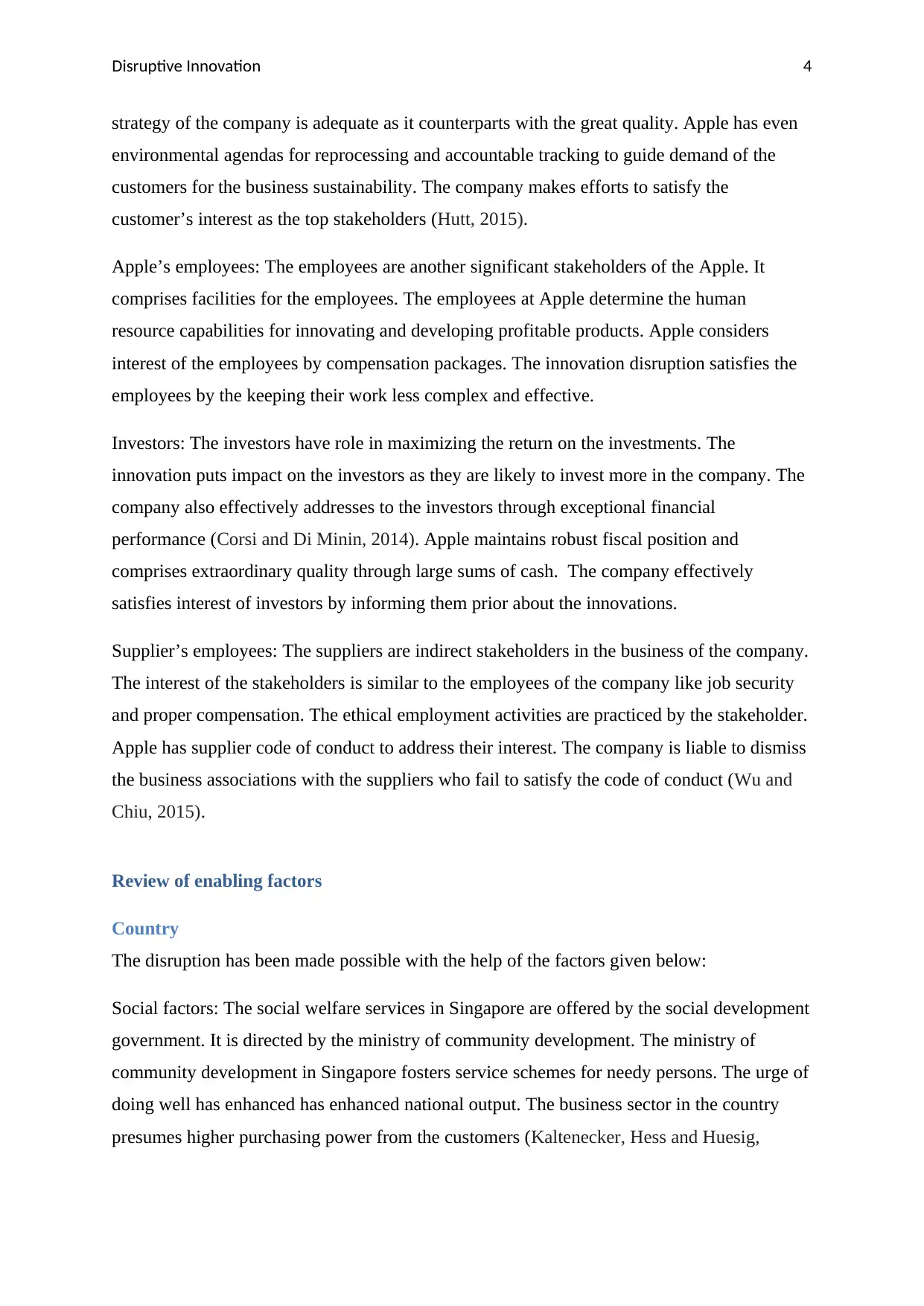
Disruptive Innovation 4
strategy of the company is adequate as it counterparts with the great quality. Apple has even
environmental agendas for reprocessing and accountable tracking to guide demand of the
customers for the business sustainability. The company makes efforts to satisfy the
customer’s interest as the top stakeholders (Hutt, 2015).
Apple’s employees: The employees are another significant stakeholders of the Apple. It
comprises facilities for the employees. The employees at Apple determine the human
resource capabilities for innovating and developing profitable products. Apple considers
interest of the employees by compensation packages. The innovation disruption satisfies the
employees by the keeping their work less complex and effective.
Investors: The investors have role in maximizing the return on the investments. The
innovation puts impact on the investors as they are likely to invest more in the company. The
company also effectively addresses to the investors through exceptional financial
performance (Corsi and Di Minin, 2014). Apple maintains robust fiscal position and
comprises extraordinary quality through large sums of cash. The company effectively
satisfies interest of investors by informing them prior about the innovations.
Supplier’s employees: The suppliers are indirect stakeholders in the business of the company.
The interest of the stakeholders is similar to the employees of the company like job security
and proper compensation. The ethical employment activities are practiced by the stakeholder.
Apple has supplier code of conduct to address their interest. The company is liable to dismiss
the business associations with the suppliers who fail to satisfy the code of conduct (Wu and
Chiu, 2015).
Review of enabling factors
Country
The disruption has been made possible with the help of the factors given below:
Social factors: The social welfare services in Singapore are offered by the social development
government. It is directed by the ministry of community development. The ministry of
community development in Singapore fosters service schemes for needy persons. The urge of
doing well has enhanced has enhanced national output. The business sector in the country
presumes higher purchasing power from the customers (Kaltenecker, Hess and Huesig,
strategy of the company is adequate as it counterparts with the great quality. Apple has even
environmental agendas for reprocessing and accountable tracking to guide demand of the
customers for the business sustainability. The company makes efforts to satisfy the
customer’s interest as the top stakeholders (Hutt, 2015).
Apple’s employees: The employees are another significant stakeholders of the Apple. It
comprises facilities for the employees. The employees at Apple determine the human
resource capabilities for innovating and developing profitable products. Apple considers
interest of the employees by compensation packages. The innovation disruption satisfies the
employees by the keeping their work less complex and effective.
Investors: The investors have role in maximizing the return on the investments. The
innovation puts impact on the investors as they are likely to invest more in the company. The
company also effectively addresses to the investors through exceptional financial
performance (Corsi and Di Minin, 2014). Apple maintains robust fiscal position and
comprises extraordinary quality through large sums of cash. The company effectively
satisfies interest of investors by informing them prior about the innovations.
Supplier’s employees: The suppliers are indirect stakeholders in the business of the company.
The interest of the stakeholders is similar to the employees of the company like job security
and proper compensation. The ethical employment activities are practiced by the stakeholder.
Apple has supplier code of conduct to address their interest. The company is liable to dismiss
the business associations with the suppliers who fail to satisfy the code of conduct (Wu and
Chiu, 2015).
Review of enabling factors
Country
The disruption has been made possible with the help of the factors given below:
Social factors: The social welfare services in Singapore are offered by the social development
government. It is directed by the ministry of community development. The ministry of
community development in Singapore fosters service schemes for needy persons. The urge of
doing well has enhanced has enhanced national output. The business sector in the country
presumes higher purchasing power from the customers (Kaltenecker, Hess and Huesig,
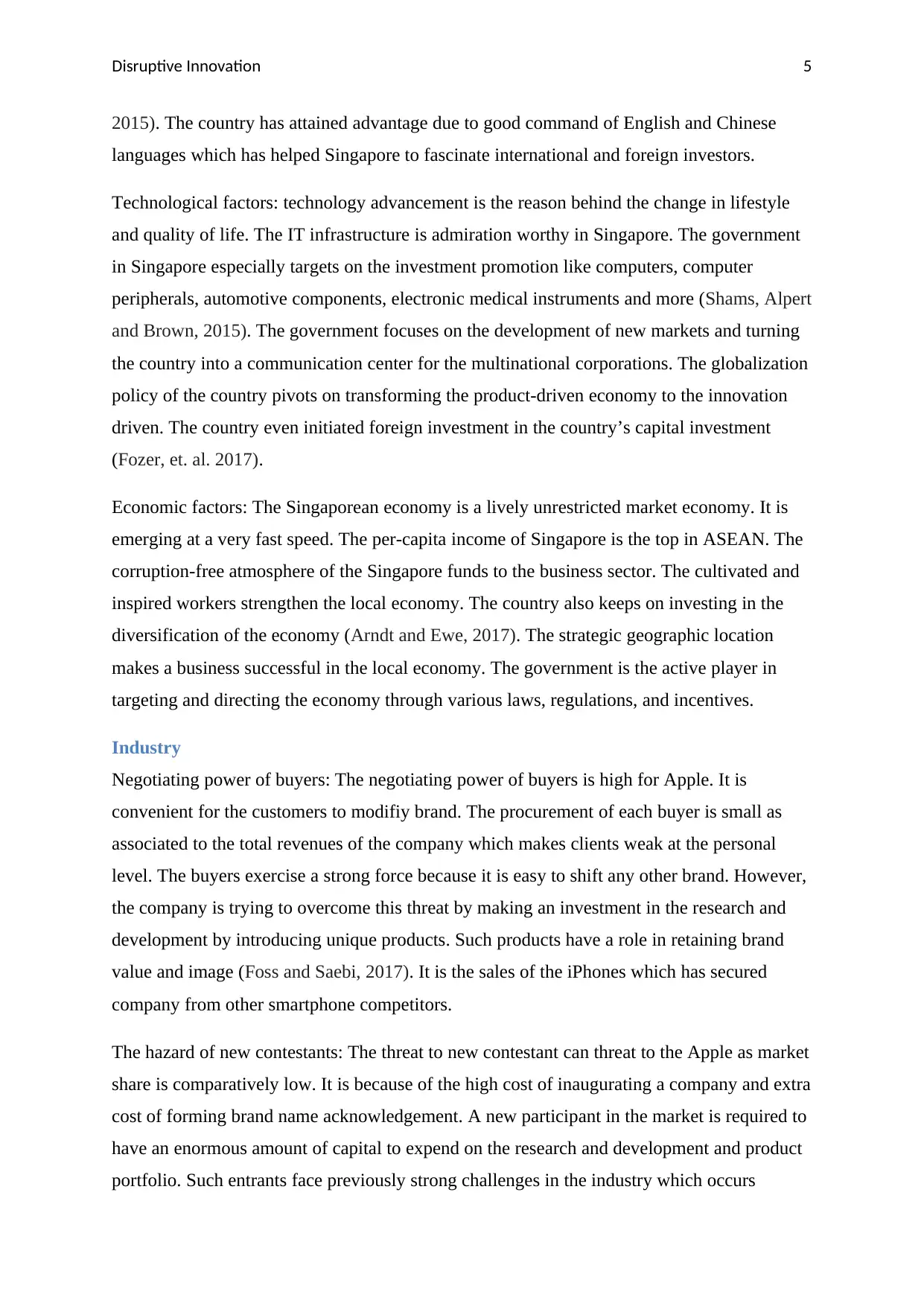
Disruptive Innovation 5
2015). The country has attained advantage due to good command of English and Chinese
languages which has helped Singapore to fascinate international and foreign investors.
Technological factors: technology advancement is the reason behind the change in lifestyle
and quality of life. The IT infrastructure is admiration worthy in Singapore. The government
in Singapore especially targets on the investment promotion like computers, computer
peripherals, automotive components, electronic medical instruments and more (Shams, Alpert
and Brown, 2015). The government focuses on the development of new markets and turning
the country into a communication center for the multinational corporations. The globalization
policy of the country pivots on transforming the product-driven economy to the innovation
driven. The country even initiated foreign investment in the country’s capital investment
(Fozer, et. al. 2017).
Economic factors: The Singaporean economy is a lively unrestricted market economy. It is
emerging at a very fast speed. The per-capita income of Singapore is the top in ASEAN. The
corruption-free atmosphere of the Singapore funds to the business sector. The cultivated and
inspired workers strengthen the local economy. The country also keeps on investing in the
diversification of the economy (Arndt and Ewe, 2017). The strategic geographic location
makes a business successful in the local economy. The government is the active player in
targeting and directing the economy through various laws, regulations, and incentives.
Industry
Negotiating power of buyers: The negotiating power of buyers is high for Apple. It is
convenient for the customers to modifiy brand. The procurement of each buyer is small as
associated to the total revenues of the company which makes clients weak at the personal
level. The buyers exercise a strong force because it is easy to shift any other brand. However,
the company is trying to overcome this threat by making an investment in the research and
development by introducing unique products. Such products have a role in retaining brand
value and image (Foss and Saebi, 2017). It is the sales of the iPhones which has secured
company from other smartphone competitors.
The hazard of new contestants: The threat to new contestant can threat to the Apple as market
share is comparatively low. It is because of the high cost of inaugurating a company and extra
cost of forming brand name acknowledgement. A new participant in the market is required to
have an enormous amount of capital to expend on the research and development and product
portfolio. Such entrants face previously strong challenges in the industry which occurs
2015). The country has attained advantage due to good command of English and Chinese
languages which has helped Singapore to fascinate international and foreign investors.
Technological factors: technology advancement is the reason behind the change in lifestyle
and quality of life. The IT infrastructure is admiration worthy in Singapore. The government
in Singapore especially targets on the investment promotion like computers, computer
peripherals, automotive components, electronic medical instruments and more (Shams, Alpert
and Brown, 2015). The government focuses on the development of new markets and turning
the country into a communication center for the multinational corporations. The globalization
policy of the country pivots on transforming the product-driven economy to the innovation
driven. The country even initiated foreign investment in the country’s capital investment
(Fozer, et. al. 2017).
Economic factors: The Singaporean economy is a lively unrestricted market economy. It is
emerging at a very fast speed. The per-capita income of Singapore is the top in ASEAN. The
corruption-free atmosphere of the Singapore funds to the business sector. The cultivated and
inspired workers strengthen the local economy. The country also keeps on investing in the
diversification of the economy (Arndt and Ewe, 2017). The strategic geographic location
makes a business successful in the local economy. The government is the active player in
targeting and directing the economy through various laws, regulations, and incentives.
Industry
Negotiating power of buyers: The negotiating power of buyers is high for Apple. It is
convenient for the customers to modifiy brand. The procurement of each buyer is small as
associated to the total revenues of the company which makes clients weak at the personal
level. The buyers exercise a strong force because it is easy to shift any other brand. However,
the company is trying to overcome this threat by making an investment in the research and
development by introducing unique products. Such products have a role in retaining brand
value and image (Foss and Saebi, 2017). It is the sales of the iPhones which has secured
company from other smartphone competitors.
The hazard of new contestants: The threat to new contestant can threat to the Apple as market
share is comparatively low. It is because of the high cost of inaugurating a company and extra
cost of forming brand name acknowledgement. A new participant in the market is required to
have an enormous amount of capital to expend on the research and development and product
portfolio. Such entrants face previously strong challenges in the industry which occurs
⊘ This is a preview!⊘
Do you want full access?
Subscribe today to unlock all pages.

Trusted by 1+ million students worldwide
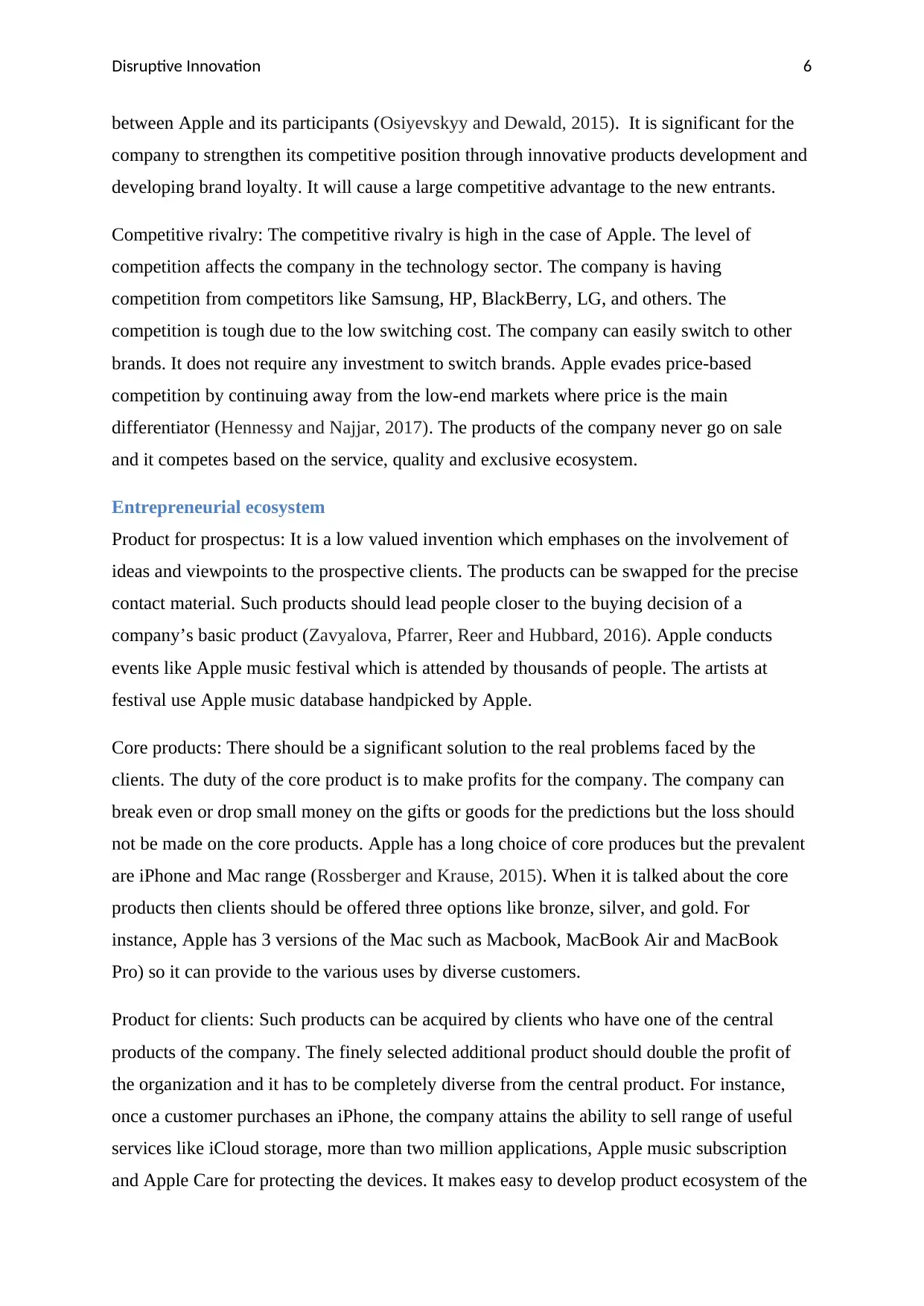
Disruptive Innovation 6
between Apple and its participants (Osiyevskyy and Dewald, 2015). It is significant for the
company to strengthen its competitive position through innovative products development and
developing brand loyalty. It will cause a large competitive advantage to the new entrants.
Competitive rivalry: The competitive rivalry is high in the case of Apple. The level of
competition affects the company in the technology sector. The company is having
competition from competitors like Samsung, HP, BlackBerry, LG, and others. The
competition is tough due to the low switching cost. The company can easily switch to other
brands. It does not require any investment to switch brands. Apple evades price-based
competition by continuing away from the low-end markets where price is the main
differentiator (Hennessy and Najjar, 2017). The products of the company never go on sale
and it competes based on the service, quality and exclusive ecosystem.
Entrepreneurial ecosystem
Product for prospectus: It is a low valued invention which emphases on the involvement of
ideas and viewpoints to the prospective clients. The products can be swapped for the precise
contact material. Such products should lead people closer to the buying decision of a
company’s basic product (Zavyalova, Pfarrer, Reer and Hubbard, 2016). Apple conducts
events like Apple music festival which is attended by thousands of people. The artists at
festival use Apple music database handpicked by Apple.
Core products: There should be a significant solution to the real problems faced by the
clients. The duty of the core product is to make profits for the company. The company can
break even or drop small money on the gifts or goods for the predictions but the loss should
not be made on the core products. Apple has a long choice of core produces but the prevalent
are iPhone and Mac range (Rossberger and Krause, 2015). When it is talked about the core
products then clients should be offered three options like bronze, silver, and gold. For
instance, Apple has 3 versions of the Mac such as Macbook, MacBook Air and MacBook
Pro) so it can provide to the various uses by diverse customers.
Product for clients: Such products can be acquired by clients who have one of the central
products of the company. The finely selected additional product should double the profit of
the organization and it has to be completely diverse from the central product. For instance,
once a customer purchases an iPhone, the company attains the ability to sell range of useful
services like iCloud storage, more than two million applications, Apple music subscription
and Apple Care for protecting the devices. It makes easy to develop product ecosystem of the
between Apple and its participants (Osiyevskyy and Dewald, 2015). It is significant for the
company to strengthen its competitive position through innovative products development and
developing brand loyalty. It will cause a large competitive advantage to the new entrants.
Competitive rivalry: The competitive rivalry is high in the case of Apple. The level of
competition affects the company in the technology sector. The company is having
competition from competitors like Samsung, HP, BlackBerry, LG, and others. The
competition is tough due to the low switching cost. The company can easily switch to other
brands. It does not require any investment to switch brands. Apple evades price-based
competition by continuing away from the low-end markets where price is the main
differentiator (Hennessy and Najjar, 2017). The products of the company never go on sale
and it competes based on the service, quality and exclusive ecosystem.
Entrepreneurial ecosystem
Product for prospectus: It is a low valued invention which emphases on the involvement of
ideas and viewpoints to the prospective clients. The products can be swapped for the precise
contact material. Such products should lead people closer to the buying decision of a
company’s basic product (Zavyalova, Pfarrer, Reer and Hubbard, 2016). Apple conducts
events like Apple music festival which is attended by thousands of people. The artists at
festival use Apple music database handpicked by Apple.
Core products: There should be a significant solution to the real problems faced by the
clients. The duty of the core product is to make profits for the company. The company can
break even or drop small money on the gifts or goods for the predictions but the loss should
not be made on the core products. Apple has a long choice of core produces but the prevalent
are iPhone and Mac range (Rossberger and Krause, 2015). When it is talked about the core
products then clients should be offered three options like bronze, silver, and gold. For
instance, Apple has 3 versions of the Mac such as Macbook, MacBook Air and MacBook
Pro) so it can provide to the various uses by diverse customers.
Product for clients: Such products can be acquired by clients who have one of the central
products of the company. The finely selected additional product should double the profit of
the organization and it has to be completely diverse from the central product. For instance,
once a customer purchases an iPhone, the company attains the ability to sell range of useful
services like iCloud storage, more than two million applications, Apple music subscription
and Apple Care for protecting the devices. It makes easy to develop product ecosystem of the
Paraphrase This Document
Need a fresh take? Get an instant paraphrase of this document with our AI Paraphraser
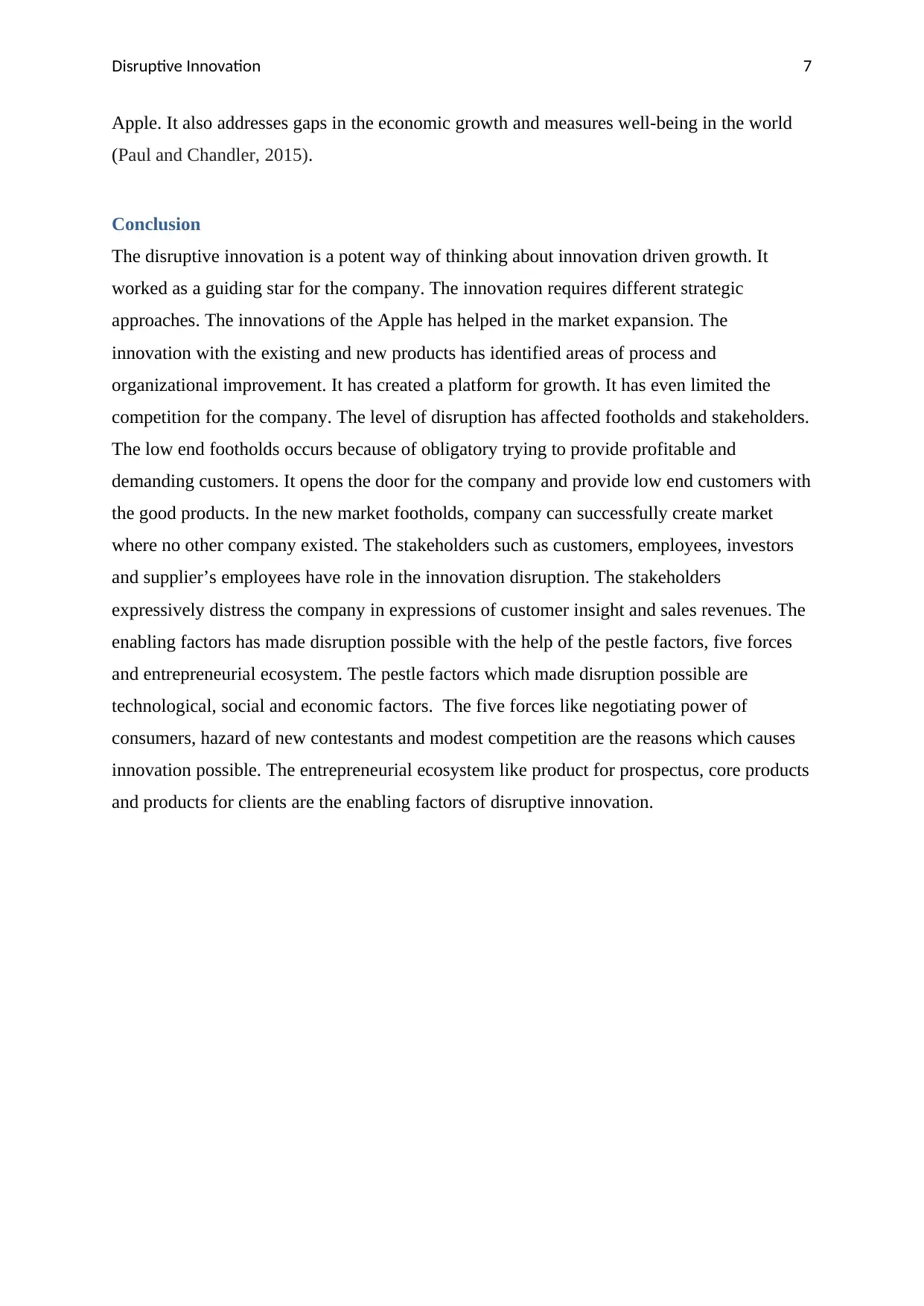
Disruptive Innovation 7
Apple. It also addresses gaps in the economic growth and measures well-being in the world
(Paul and Chandler, 2015).
Conclusion
The disruptive innovation is a potent way of thinking about innovation driven growth. It
worked as a guiding star for the company. The innovation requires different strategic
approaches. The innovations of the Apple has helped in the market expansion. The
innovation with the existing and new products has identified areas of process and
organizational improvement. It has created a platform for growth. It has even limited the
competition for the company. The level of disruption has affected footholds and stakeholders.
The low end footholds occurs because of obligatory trying to provide profitable and
demanding customers. It opens the door for the company and provide low end customers with
the good products. In the new market footholds, company can successfully create market
where no other company existed. The stakeholders such as customers, employees, investors
and supplier’s employees have role in the innovation disruption. The stakeholders
expressively distress the company in expressions of customer insight and sales revenues. The
enabling factors has made disruption possible with the help of the pestle factors, five forces
and entrepreneurial ecosystem. The pestle factors which made disruption possible are
technological, social and economic factors. The five forces like negotiating power of
consumers, hazard of new contestants and modest competition are the reasons which causes
innovation possible. The entrepreneurial ecosystem like product for prospectus, core products
and products for clients are the enabling factors of disruptive innovation.
Apple. It also addresses gaps in the economic growth and measures well-being in the world
(Paul and Chandler, 2015).
Conclusion
The disruptive innovation is a potent way of thinking about innovation driven growth. It
worked as a guiding star for the company. The innovation requires different strategic
approaches. The innovations of the Apple has helped in the market expansion. The
innovation with the existing and new products has identified areas of process and
organizational improvement. It has created a platform for growth. It has even limited the
competition for the company. The level of disruption has affected footholds and stakeholders.
The low end footholds occurs because of obligatory trying to provide profitable and
demanding customers. It opens the door for the company and provide low end customers with
the good products. In the new market footholds, company can successfully create market
where no other company existed. The stakeholders such as customers, employees, investors
and supplier’s employees have role in the innovation disruption. The stakeholders
expressively distress the company in expressions of customer insight and sales revenues. The
enabling factors has made disruption possible with the help of the pestle factors, five forces
and entrepreneurial ecosystem. The pestle factors which made disruption possible are
technological, social and economic factors. The five forces like negotiating power of
consumers, hazard of new contestants and modest competition are the reasons which causes
innovation possible. The entrepreneurial ecosystem like product for prospectus, core products
and products for clients are the enabling factors of disruptive innovation.

Disruptive Innovation 8
References
Arndt, H.K. and Ewe, C., 2017. Analysis of Product Lifecycle Data to Determine the
Environmental Impact of the Apple iPhone. In Advances and New Trends in Environmental
Informatics (pp. 3-13). Springer, Cham.
Christensen, C.M., Raynor, M.E. and McDonald, R., 2015. What is disruptive
innovation. Harvard Business Review, 93(12), pp.44-53.
Clarke, T. and Boersma, M., 2017. The governance of global value chains: Unresolved
human rights, environmental and ethical dilemmas in the apple supply chain. Journal of
Business Ethics, 143(1), pp.111-131.
Corsi, S. and Di Minin, A., 2014. Disruptive innovation… in reverse: Adding a geographical
dimension to disruptive innovation theory. Creativity and Innovation Management, 23(1),
pp.76-90.
Foss, N.J. and Saebi, T., 2017. Fifteen years of research on business model innovation: How
far have we come, and where should we go?. Journal of Management, 43(1), pp.200-227.
Fozer, D., Sziraky, F.Z., Racz, L., Nagy, T., Tarjani, A.J., Toth, A.J., Haaz, E., Benko, T. and
Mizsey, P., 2017. Life cycle, PESTLE and multi-criteria decision analysis of CCS process
alternatives. Journal of Cleaner Production, 147, pp.75-85.
Hennessy, J. and Najjar, A., 2017. Apple Computer, Inc.: Think Different, Think Online
Music. Kellogg School of Management Cases, pp.1-24.
Hutt, R.W., 2015. Middle market companies: reaching stakeholders through strategic
communication. Journal of Business Strategy, 36(5), pp.25-33.
Kaltenecker, N., Hess, T. and Huesig, S., 2015. Managing potentially disruptive innovations
in software companies: Transforming from On-premises to the On-demand. The Journal of
Strategic Information Systems, 24(4), pp.234-250.
Nagy, D., Schuessler, J. and Dubinsky, A., 2016. Defining and identifying disruptive
innovations. Industrial Marketing Management, 57, pp.119-126.
References
Arndt, H.K. and Ewe, C., 2017. Analysis of Product Lifecycle Data to Determine the
Environmental Impact of the Apple iPhone. In Advances and New Trends in Environmental
Informatics (pp. 3-13). Springer, Cham.
Christensen, C.M., Raynor, M.E. and McDonald, R., 2015. What is disruptive
innovation. Harvard Business Review, 93(12), pp.44-53.
Clarke, T. and Boersma, M., 2017. The governance of global value chains: Unresolved
human rights, environmental and ethical dilemmas in the apple supply chain. Journal of
Business Ethics, 143(1), pp.111-131.
Corsi, S. and Di Minin, A., 2014. Disruptive innovation… in reverse: Adding a geographical
dimension to disruptive innovation theory. Creativity and Innovation Management, 23(1),
pp.76-90.
Foss, N.J. and Saebi, T., 2017. Fifteen years of research on business model innovation: How
far have we come, and where should we go?. Journal of Management, 43(1), pp.200-227.
Fozer, D., Sziraky, F.Z., Racz, L., Nagy, T., Tarjani, A.J., Toth, A.J., Haaz, E., Benko, T. and
Mizsey, P., 2017. Life cycle, PESTLE and multi-criteria decision analysis of CCS process
alternatives. Journal of Cleaner Production, 147, pp.75-85.
Hennessy, J. and Najjar, A., 2017. Apple Computer, Inc.: Think Different, Think Online
Music. Kellogg School of Management Cases, pp.1-24.
Hutt, R.W., 2015. Middle market companies: reaching stakeholders through strategic
communication. Journal of Business Strategy, 36(5), pp.25-33.
Kaltenecker, N., Hess, T. and Huesig, S., 2015. Managing potentially disruptive innovations
in software companies: Transforming from On-premises to the On-demand. The Journal of
Strategic Information Systems, 24(4), pp.234-250.
Nagy, D., Schuessler, J. and Dubinsky, A., 2016. Defining and identifying disruptive
innovations. Industrial Marketing Management, 57, pp.119-126.
⊘ This is a preview!⊘
Do you want full access?
Subscribe today to unlock all pages.

Trusted by 1+ million students worldwide
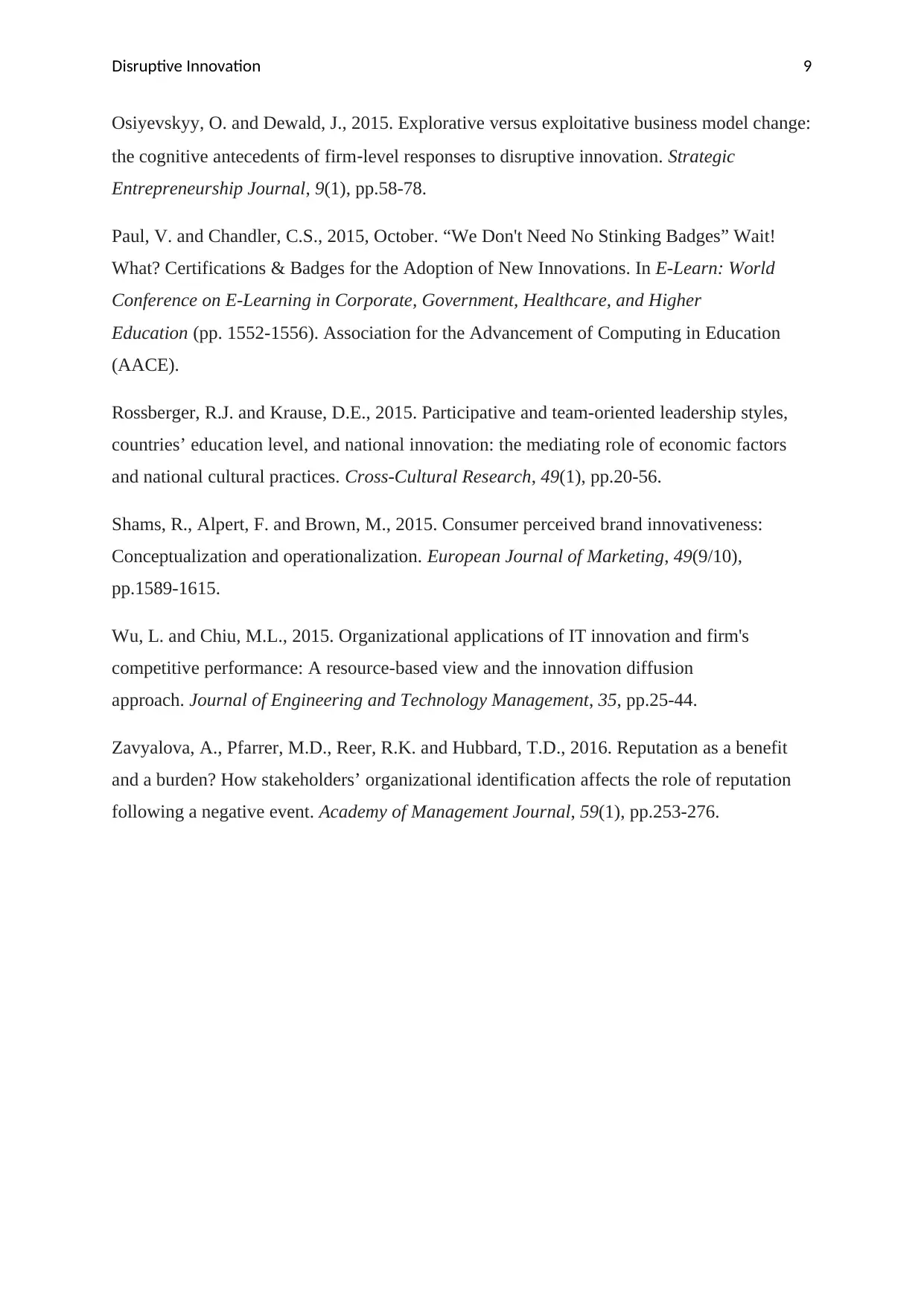
Disruptive Innovation 9
Osiyevskyy, O. and Dewald, J., 2015. Explorative versus exploitative business model change:
the cognitive antecedents of firm‐level responses to disruptive innovation. Strategic
Entrepreneurship Journal, 9(1), pp.58-78.
Paul, V. and Chandler, C.S., 2015, October. “We Don't Need No Stinking Badges” Wait!
What? Certifications & Badges for the Adoption of New Innovations. In E-Learn: World
Conference on E-Learning in Corporate, Government, Healthcare, and Higher
Education (pp. 1552-1556). Association for the Advancement of Computing in Education
(AACE).
Rossberger, R.J. and Krause, D.E., 2015. Participative and team-oriented leadership styles,
countries’ education level, and national innovation: the mediating role of economic factors
and national cultural practices. Cross-Cultural Research, 49(1), pp.20-56.
Shams, R., Alpert, F. and Brown, M., 2015. Consumer perceived brand innovativeness:
Conceptualization and operationalization. European Journal of Marketing, 49(9/10),
pp.1589-1615.
Wu, L. and Chiu, M.L., 2015. Organizational applications of IT innovation and firm's
competitive performance: A resource-based view and the innovation diffusion
approach. Journal of Engineering and Technology Management, 35, pp.25-44.
Zavyalova, A., Pfarrer, M.D., Reer, R.K. and Hubbard, T.D., 2016. Reputation as a benefit
and a burden? How stakeholders’ organizational identification affects the role of reputation
following a negative event. Academy of Management Journal, 59(1), pp.253-276.
Osiyevskyy, O. and Dewald, J., 2015. Explorative versus exploitative business model change:
the cognitive antecedents of firm‐level responses to disruptive innovation. Strategic
Entrepreneurship Journal, 9(1), pp.58-78.
Paul, V. and Chandler, C.S., 2015, October. “We Don't Need No Stinking Badges” Wait!
What? Certifications & Badges for the Adoption of New Innovations. In E-Learn: World
Conference on E-Learning in Corporate, Government, Healthcare, and Higher
Education (pp. 1552-1556). Association for the Advancement of Computing in Education
(AACE).
Rossberger, R.J. and Krause, D.E., 2015. Participative and team-oriented leadership styles,
countries’ education level, and national innovation: the mediating role of economic factors
and national cultural practices. Cross-Cultural Research, 49(1), pp.20-56.
Shams, R., Alpert, F. and Brown, M., 2015. Consumer perceived brand innovativeness:
Conceptualization and operationalization. European Journal of Marketing, 49(9/10),
pp.1589-1615.
Wu, L. and Chiu, M.L., 2015. Organizational applications of IT innovation and firm's
competitive performance: A resource-based view and the innovation diffusion
approach. Journal of Engineering and Technology Management, 35, pp.25-44.
Zavyalova, A., Pfarrer, M.D., Reer, R.K. and Hubbard, T.D., 2016. Reputation as a benefit
and a burden? How stakeholders’ organizational identification affects the role of reputation
following a negative event. Academy of Management Journal, 59(1), pp.253-276.
Paraphrase This Document
Need a fresh take? Get an instant paraphrase of this document with our AI Paraphraser
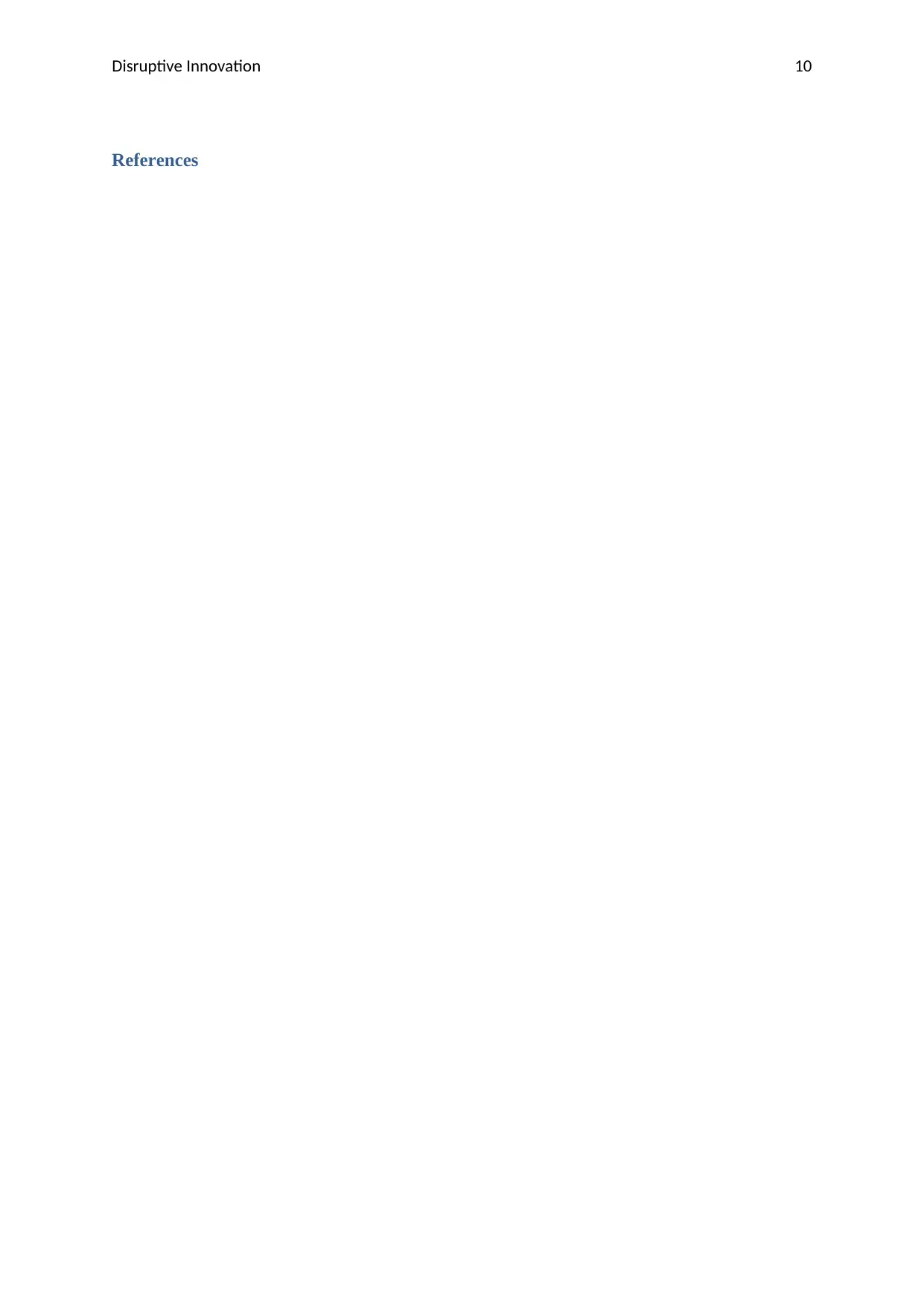
Disruptive Innovation 10
References
References
1 out of 11
Related Documents
Your All-in-One AI-Powered Toolkit for Academic Success.
+13062052269
info@desklib.com
Available 24*7 on WhatsApp / Email
![[object Object]](/_next/static/media/star-bottom.7253800d.svg)
Unlock your academic potential
Copyright © 2020–2025 A2Z Services. All Rights Reserved. Developed and managed by ZUCOL.




